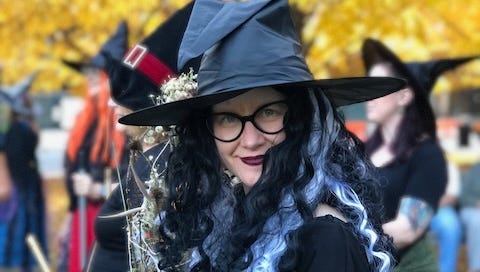When I was 14, I wanted to be a witch.
I don't mean a Halloween witch. I mean a Wiccan witch, in a coven, practicing spells and holding rituals. Honoring the four directions, or whatever it was witches did.
These days I get my witch fix during the annual Oak Park Witch Dance, where we show up downtown and just start dancing to a German song called “Shake your bacon.” If you live in Oak Park, you know this is normal.
The Spiral Dance
I was skimming the titles in my little hometown library and came across The Spiral Dance, by Starhawk, published in 1979. I didn't know then that this was a pivotal title for Wiccans. I just knew it answered a question in me. What question? I don't know. Just...a question.
The jacket copy:
"...an unparalleled reference on the practices and philosophies of Witchcraft and a guide to the life-affirming ways in which readers can turn to the Goddess to deepen their sense of personal pride, develop their inner power, and integrate mind, body, and spirit. Starhawk's brilliant, comprehensive overview of the growth, suppression, and modern-day re-emergence of Wicca as a Goddess-worshipping religion has left an indelible mark on the feminist spiritual consciousness."
I pulled the book off the shelf and found a corner in the Glen Ellyn library where I could sprawl on the carpet and read surreptitiously. Glen Ellyn wasn't a particularly Wiccan town in the 1980s. In fact, I'm not sure I could have found anyone who had heard the word Wiccan in the small Chicago suburb. But when I entered high school in the Bay Area outside San Francisco, I saw signs. I found people. I mean, obviously.
A real spiral dance
A family friend took me to a real spiral dance, a Wiccan ritual “honoring the goddess within and without.” It was held in a warehouse on the Bay, and it was packed. Hundreds of us linked arms and wound into a gorgeous spiral. I pictured it from above, the swirl of flowing skirts and flower crowns. The drums and chanting growing louder, the fumes of patchouli rising in the heat. I felt transported. I was 16, an ideal age for being transported, for believing in the promise of a very old religion to address my very new wounds and desires.

On not finding a coven
One problem with being a 16-year-old witch is that you have no idea what you're doing. I had this one book. It was hard, without the internet, to find a coven. I could only hope for magic to lead me to likeminded spirits. Another problem is that I was interested in one million other things. I was busy rehearsing four nights a week for high school plays. Busy playing Dungeons & Dragons. Busy dressing up in vintage costumes "borrowed" from the theater department and going to diners with my friends. Busy tormenting my younger sister. Busy dating older boys.
I could spare a little time to light a candle and read a spell from Starhawk's book, follow her step-by-step directions, and hope to cure a broken heart. But then the phone would ring, and it would be Adam on one line, and Richard on call waiting, and then I would have to call one of them back, and then I would have to yank the spiral cord into my room and wrap it around my fingers and call Pete and Dave and Molly and spend two hours organizing a plan. I mean, my calendar was full.
Sorry about the book
I never returned The Spiral Dance to the Glen Ellyn library. Boxed with keepsakes, it’s still dog-eared, the spine cracked. Today, I always return library books. Thankfully, they didn't come after me with those fines. But they should have. With great power comes great responsibility, a librarian could have said to me, winking, and I would have known we were kindred spirits, part of the spiral dance.
Magic? Remain open.
Today, I believe in the power of whatever heals you. The key that unlocks your wellbeing. Maybe it's a spiral dance. The real magic is remaining open.




